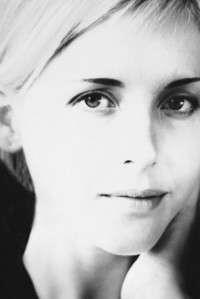Lena Herzog
Elena Herzog (née Pisetski; born in 1970) is a Russian-American visual artist and photographer.
Lena Herzog | |
|---|---|
 | |
| Born | Elena Pisetski 1970 (age 49–50) Ekaterinburg, Russian SFSR |
| Other names | Elena Herzog |
| Citizenship | United States |
| Occupation | Visual artist, photographer |
Notable work | Tauromaquia, Flamenco, Pilgrims, Lost Souls |
| Spouse(s) | |
| Website | lenaherzog |
Biography
Herzog moved to Leningrad in 1987 to attend the Philological Faculty of Leningrad University, where she studied languages (English and Spanish) and literature. In 1990, she emigrated to the United States and graduated with a degree in philosophy from Mills College, specializing in the history and philosophy of science. Herzog was also a research consultant at Stanford University.[1] She started taking photographs in 1997 and studied photographic printing techniques with Italian printer Ivan Dalla Tana in Milan and later with French printer Marc Valesella. Herzog combines some of the very early photographic darkroom processes with contemporary and her own techniques to achieve her desired effects.[2]
Herzog's work ranges from classical documentary to the experimental and conceptual and has been published and reviewed in The New Yorker,[3] The New York Times,[4] The Los Angeles Times,[5] The Paris Review,[6] Harper’s Magazine,[7] El País,[8] El Mundo[9] The Believer,[10] The British Journal of Photography,[11] and Cabinet,[12] among others. Her work has been exhibited at the Los Angeles County Museum of Art,[13] Pasadena Museum of California Art,[14] Yerba Buena Center for the Arts (San Francisco),[15] the International Center of Photography (New York),[16] and the British Museum,[17] among others.
Herzog is an American citizen, naturalized in 1999. Since 1995, she has lived in California with her husband, German filmmaker Werner Herzog. They have collaborated on several projects including a book of stills from the film Bad Lieutenant which was published by Rizzoli in 2009. Werner Herzog wrote the introduction to Lena's book Pilgrims, which was released in 2002.
Her book Strandbeest: the Dream Machines of Theo Jansen was published by TASCHEN in 2014. Herzog has authored six books / monographs of photography.
In 2016, Herzog's complex video/audio installation Last Whispers: Oratorio for Vanishing Voices, Collapsing Universes and a Falling Tree, in which she collaborated with composer and director Marco Capalbo and sound designer Mark Mangini, premiered at the British Museum in the Living and Dying Gallery adjacent to the Rosetta Stone.[17] A film and surround-sound experience that incorporates archival recordings of endangered languages, Last Whispers began a world tour in 2019.[18]
Bibliography
Books
- Strandbeest. The Dream Machines of Theo Jansen ISBN 978-3-8365-4849-6 (2014)
- Lost Souls ISBN 978-0-9825908-0-5 (2010)
- Bad Lieutenant ISBN 978-0-7893-2013-1 (2009)
- Flamenco: Dance Class ISBN 1-902699-44-0
- Tauromaquia: The Art of Bullfighting ISBN 1-902699-23-8
- Pilgrims ISBN 1-902699-43-2 (2002)
Exhibitions
- Panoramas, Fahey / Klein Gallery, Los Angeles (2012)
- Lost Souls, International Center of Photography (2010)
- The Circle of Bliss, Los Angeles County Museum of Art (2003)
- Reflecting Buddha, Pasadena Museum of California Art (2003)
- Ensayo, (multimedia show) Yerba Buena Center of the Performing Arts, San Francisco (2003)
- Flamenco, Foyles Gallery, London (2003)
- Tauromaquia, Museum of Carruajes, Seville, Spain (2002)
- Below Zero, Focus Gallery, San Francisco (2000)
- Black and White Photographs from Andalucia and Shinxiang, Focus Gallery, San Francisco (1998)
References
- Greenstreet, Rosanna. "Q & A: Lena Herzog". The Guardian, London, November 22, 2003.
- "Lena Herzog in conversation with Lawrence Weschler". June 8, 2010. Retrieved August 15, 2010.
- Frazier, Ian. "The March of the Strandbeests". The New Yorker, September 5, 2011.
- Harrison, Kathryn,"Lost Souls" ( book review). The New York Times, December 5, 2010.
- Wertheim, Margaret, "The Light Stuff," Los Angeles Times, December 5, 2004.
- Herzog, Lena & Graham Dorrington, "Archived copy". Archived from the original on 2009-10-13. Retrieved 2010-08-16.CS1 maint: archived copy as title (link) "Airship," The Paris Review, New York, Spring 2008.
- Herzog, Lena. "Garden of Rocks," Harper's Magazine, New York, May, 2008.
- Molina, Margot, "La fotógrafa rusa Lena Herzog refleja en su libro 'Tauromaquia' el sentimento de la fiesta," , Madrid, April 19, 2002.
- Cejudo, Andres Marin, , "La mirada apócrifa," El Mundo, April 16, 2002.
- Weschler, Lawrence. "Lena Herzog [Photographer]." The Believer, June 2011.
- Sumner, Dawn. "Spanish Eyes: Interview" "Archived copy". Archived from the original on 2010-04-11. Retrieved 2010-08-16.CS1 maint: archived copy as title (link), The British Journal of Photography, December 12–31, 2003.
- Herzog, Lena, "Rhapsody in Death". Cabinet Magazine, Winter 2009–2010.
- "Archived copy". Archived from the original on 2010-07-13. Retrieved 2010-08-16.CS1 maint: archived copy as title (link), "LACMA News Release," October, 2003
- "International Buddhist Film Festival Debuts at Los Angeles County Museum of Art". PRNewswire, October 23, 2003.
- "Performance Reviews". 2001. Archived from the original on July 24, 2011. Retrieved August 15, 2010.
- "Now Showing: Perspectives 2010". May 21 – September 12, 2010. Retrieved August 15, 2010.
- "Last Whispers: Oratorio for Vanished Voices, Collapsing Universes and a Falling Tree". British Museum. Retrieved October 24, 2018.
- Woolfe, Zachary (October 11, 2019). "Dying Languages Cry Out in ‘Last Whispers’". New York Times. Retrieved October 12, 2019. Print version, October 12, p. C5.